
Sir Joshua Reynolds, Three Ladies Adorning a Term of Hymen 1773. Tate.
The Exhibition Age 1760–1815
16 rooms in Historic and Early Modern British Art
The first public exhibitions bring new audiences and new status to British art. This gallery recreates the spectacle of these early displays
The first temporary exhibition of contemporary art opens in London in 1760. Many more soon follow, notably the annual summer exhibitions held from 1769 by the new Royal Academy. For the thousands of visitors attending, these exhibitions can be overwhelming, unruly experiences. Noisy, hot and overcrowded, people come for the spectacle as much as for the art. They are as bursting with paintings as with people. As in this room, the pictures are densely hung from floor to ceiling in a kaleidoscope of styles and subjects.
For artists, this brings new challenges and opportunities. They worry that their work cannot be seen properly in the crowded conditions. To stand out against the competition, they bring ever greater individuality, experimentation and even flamboyance to their work. Art becomes regularly talked about in the newspapers, and reviews from critics can make or break careers.
Exhibitions become fashionable events. Artists are able to directly address more people than ever before, beyond a small number of elite patrons. To engage this wider public, their work often reflects popular interests and current affairs. Exhibitions become places where the nation’s ideas and anxieties are expressed.
There is a new buzz around British art. A sense of national identity is projected through these exhibitions. They help define a ‘British school’, which is celebrated as a sign of the nation’s cultural wealth and progress. Exhibitions contribute to how the country imagines itself on the world stage.
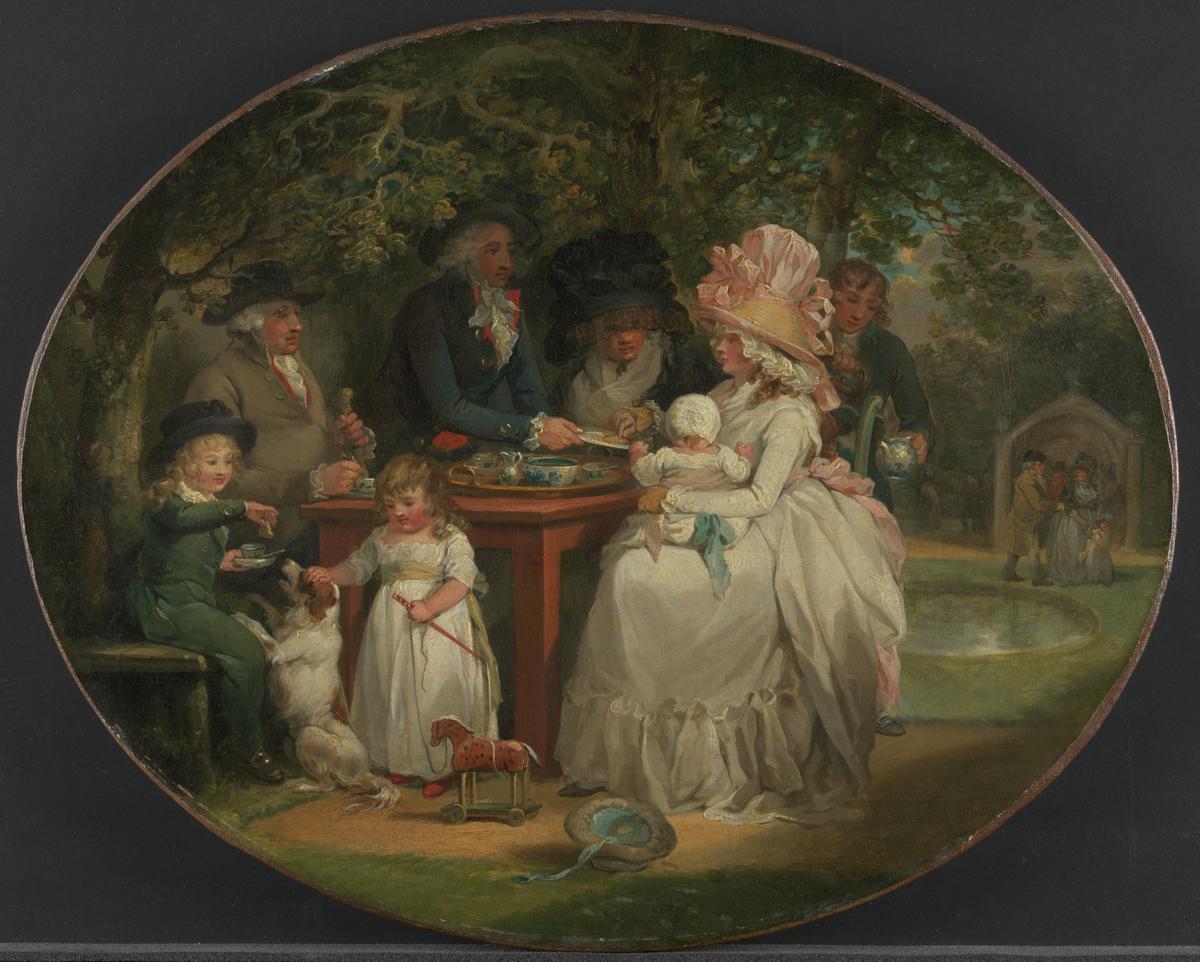
George Morland, The Tea Garden engraved 1790
This small painting shows an affluent family taking tea in a pleasure garden, a popular leisure activity in the 18th century. It perhaps shows Bagnigge Wells or Ranelagh Gardens, both on the outskirts of London. Through the slightly stiff, unsmiling appearance of the adults, George Morland may have been playing upon current humour about keeping up public appearances. Morland likely painted it with the print trade in mind: the image was first engraved in 1790, to considerable success. Morland’s work was widely reproduced in print, providing the artist with a steady income and raising his public profile.
Gallery label, February 2024
1/30
artworks in The Exhibition Age
Thomas Gainsborough, Sir Henry Bate-Dudley, Bart. c.1780
The Reverend Henry Bate-Dudley was one of London’s most notorious newspaper editors. He first rose to fame through his journalistic writing in the Morning Post, before establishing the best-selling paper, the Morning Herald in 1780, which was renowned for its social gossip and political attacks. Thomas Gainsborough was close friends with Bate-Dudley. Here, Gainsborough conveys Bate-Dudley’s self-assurance and perhaps his loyalty through including his adoring dog. For Gainsborough, their friendship guaranteed he was championed in the press. Such public support was invaluable in the competitive art world. That Bate-Dudley divided public opinion, however, is apparent in one critic’s pun about this portrait, remarking that ‘the man wanted execution’.
Gallery label, February 2024
2/30
artworks in The Exhibition Age
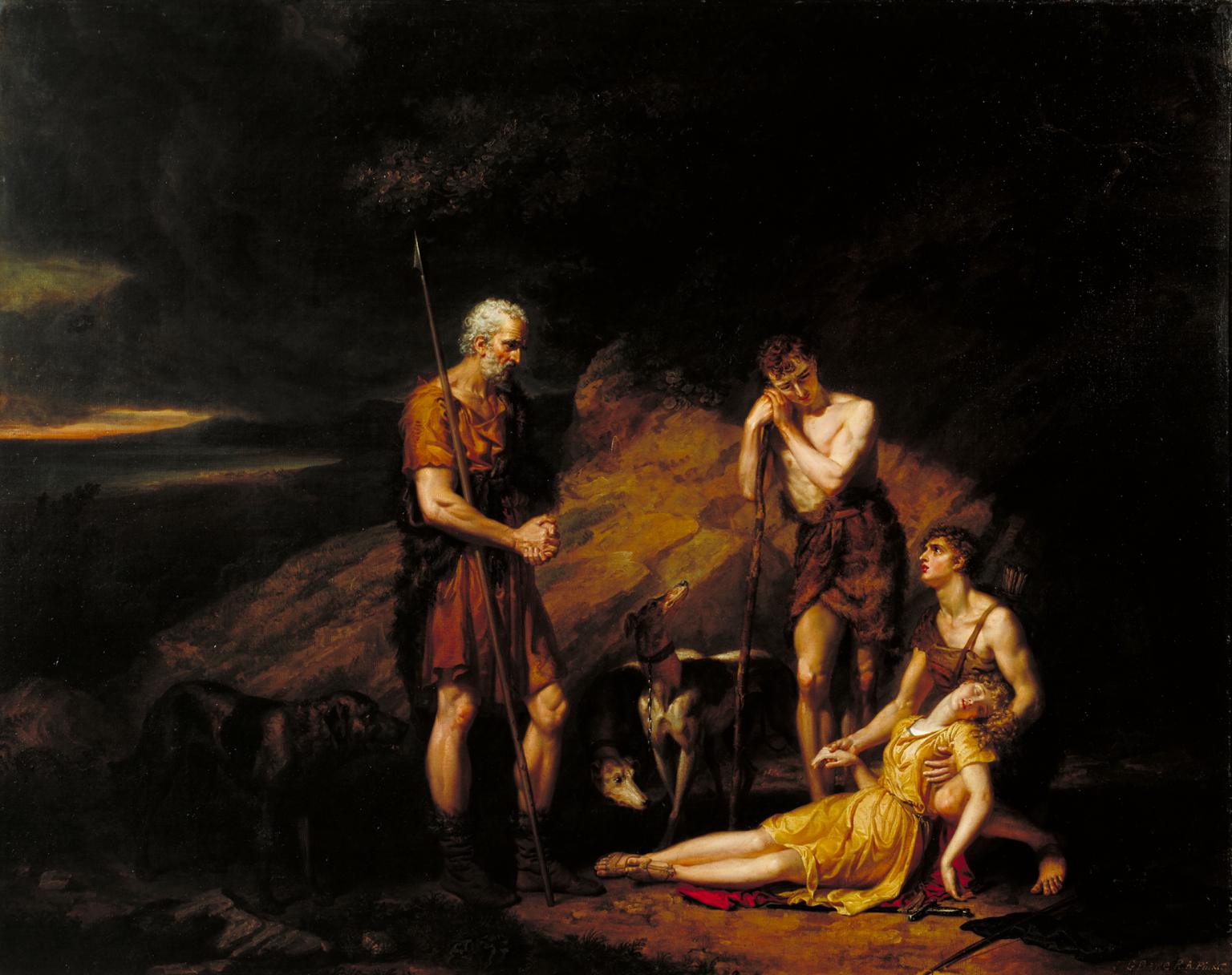
George Dawe, Imogen Found in the Cave of Belarius exhibited 1809
George Dawe depicts a scene from Shakespeare’s play Cymbeline. Imogen – the heroine and daughter of Cymbeline, the ancient king of Britain – escapes court and disguises herself as a young man. Here, Dawe shows the moment when the character Belarius (left) and Imogen’s two long-lost brothers (right) discover her in a cave. They believe she is dead, but she has actually just drunk a sleeping potion. Dawe mainly painted portraits, but here ventures into ‘history painting’ (images of biblical, mythological, literary or historical subjects). This was regarded as the highest genre of painting at the time and indicates Dawe’s ambitions as an artist. With its high-minded literary theme and dramatic lighting, this painting was meant to stand out when it was first exhibited at the British Institution in 1809.
Gallery label, October 2023
3/30
artworks in The Exhibition Age
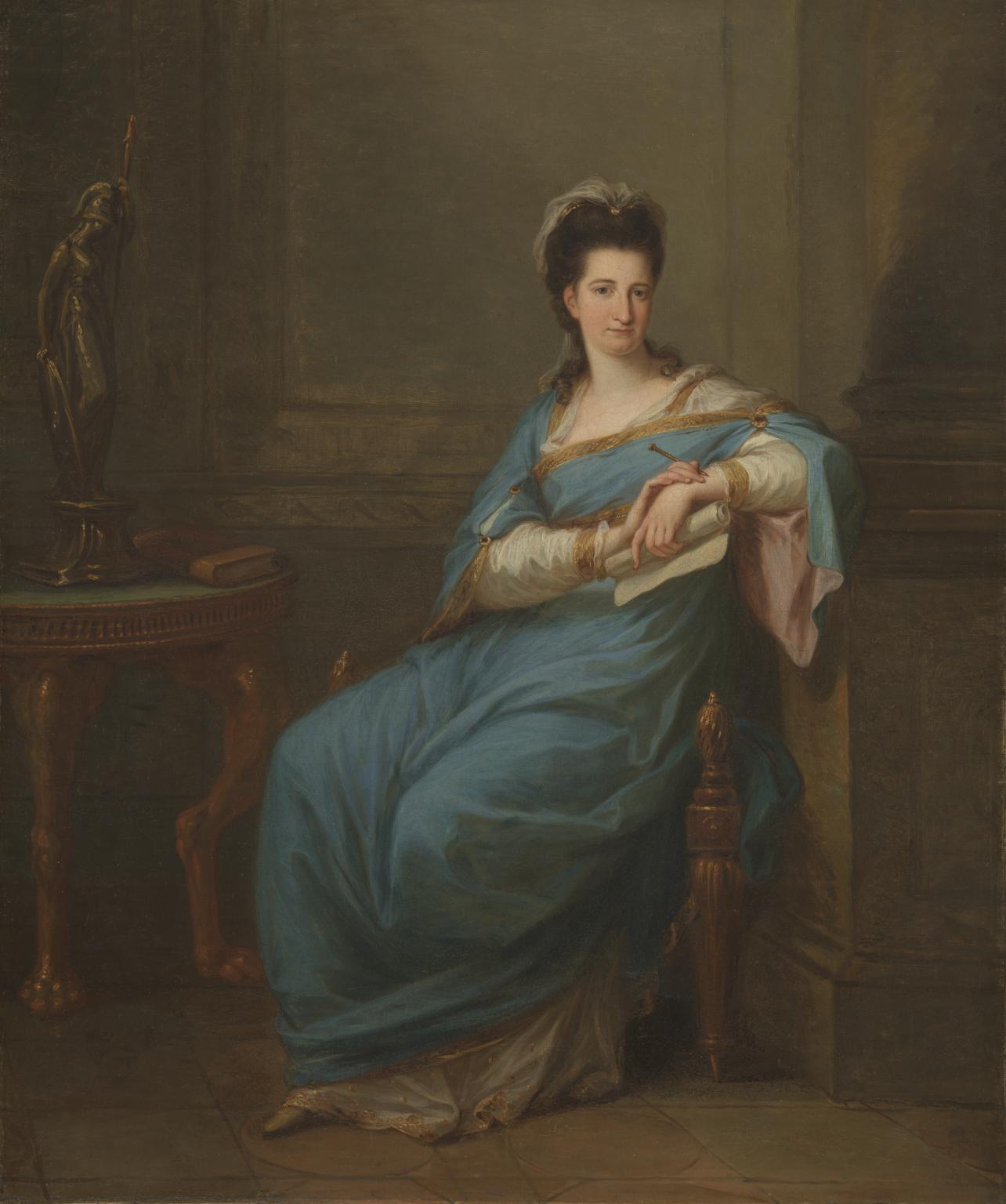
Angelica Kauffman, Portrait of a Lady c.1775
Angelica Kauffman was hugely successful – by the 1770s, her work was so popular that one contemporary quipped, ‘the whole World is Angelica-mad’. In portraits like this, Kauffman helped establish and promote an image of feminine creativity and intellect. While we do not know the sitter’s identity, the writing instruments she holds emphasise her learning, perhaps even signalling literary ambitions. The book and statue of Minerva (the Roman goddess of wisdom) on the table, further underline this. Dressed in classicising robes, she looks confidently out at the viewer. Such images also reflect the strong network of women – patrons, fellow artists, intellectuals, and professionals – that Kauffman relied upon throughout her career.
Gallery label, February 2024
4/30
artworks in The Exhibition Age

Robert Ladbrooke, Wood Scene exhibited 1806
5/30
artworks in The Exhibition Age

William Mulready, The Rattle exhibited 1808
William Mulready’s painting is quietly intimate and domestic, showing a young boy playing with a baby. This subject may reflect debates at the time about infant education, sparked by the numbers of children seen on the streets. Here, Mulready presents the family home as a place for learning, security and happiness. He exhibited the work at the British Institution in 1808. This was the first genre painting (scenes of everyday life) that he showed to the public and it marked a shift in his art, likely influenced by the popularity of similar narrative subjects by his friend, David Wilkie.
Gallery label, February 2024
6/30
artworks in The Exhibition Age

Thomas Gainsborough, Giovanna Baccelli exhibited 1782
This portrait shows the famous Italian dancer Giovanna Zanerini, known on the stage as Baccelli, at the height of her career. Her elaborate costume seems to be adapted from the ballet Les Amants Surpris in which she had recently taken London by storm. Baccelli was the mistress of John Sackville, 3rd Duke of Dorset who commissioned the painting. The rapid brushwork, translucent paint and shimmering light effects are typical of Gainsborough’s style at this time. When the portrait was first exhibited, it was chiefly praised as an excellent likeness; ‘as the Original, light airy and elegant’.
Gallery label, February 2016
7/30
artworks in The Exhibition Age

George Stubbs, Horse Devoured by a Lion ?exhibited 1763
This is one of at least 17 works Stubbs made of a lion stalking and attacking a horse. Here he depicts the moment the lion sinks its teeth into the terrified horse, set against the backdrop of Creswell Crags in the Peak District. The painting showcases Stubbs’s anatomical precision, informed by his studies of caged lions at the Tower of London. It also highlights his efforts to raise the status of animal painting by showing its emotional and narrative power. By depicting the dramatic climax of the encounter, Stubbs evokes the awe and terror felt when faced with untamed nature.
Gallery label, December 2020
8/30
artworks in The Exhibition Age
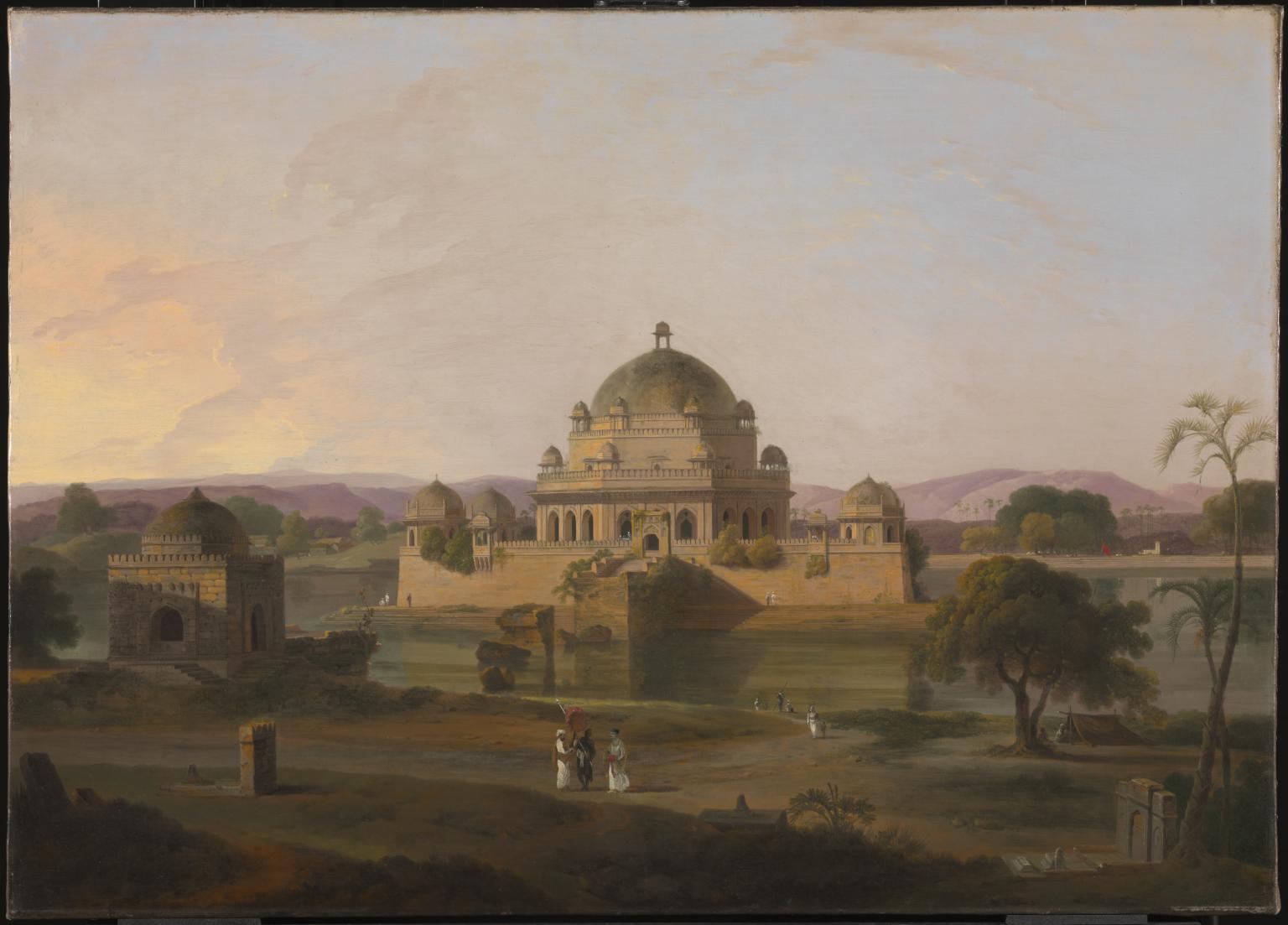
Thomas Daniell, Sher Shah’s Mausoleum, Sasaram 1810
This painting shows the monumental mausoleum of Sher Shah Suri (ruler of northern India from 1540–45) in Sasaram, a city in north-eastern India. Thomas Daniell and his nephew, William, visited Sasaram in February 1790 while undertaking an extensive tour to sketch sites across northern India. Daniell made this painting after his return to England, exhibiting it at the Royal Academy in London in 1810. Such images of India were popular with British audiences, offering a kind of armchair tourism. Daniell’s art helped shape British perceptions of Indian scenery and architecture.
Gallery label, August 2024
9/30
artworks in The Exhibition Age
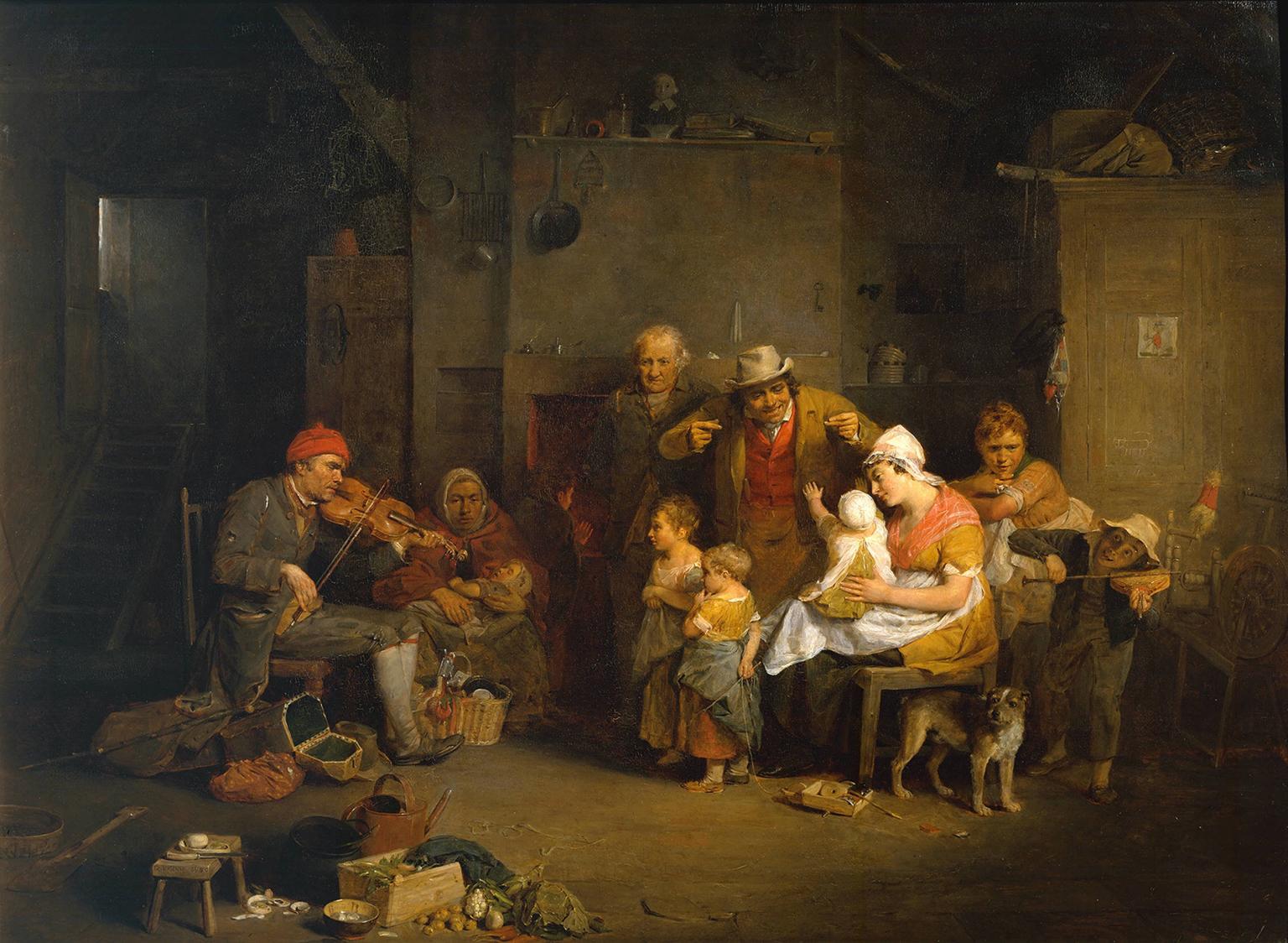
Sir David Wilkie, The Blind Fiddler 1806
David Wilkie suggests the emotional power of music here. He expresses the different reactions to the blind fiddler’s music – one young boy even pretends to play the fire bellows. This was only the second painting Wilkie exhibited publicly and it confirmed his reputation as a rising new star. A large crowd gathered around the picture when it was displayed at the Royal Academy. Exhibition-goers admired his observational skills, his characterisation, and his sympathetic view of everyday domestic life. It was hung next to JMW Turner’s A Country Blacksmith, which had a similarly subject and muted colours. Many contemporaries believed Turner was sparring with the younger artist.
Gallery label, February 2024
10/30
artworks in The Exhibition Age
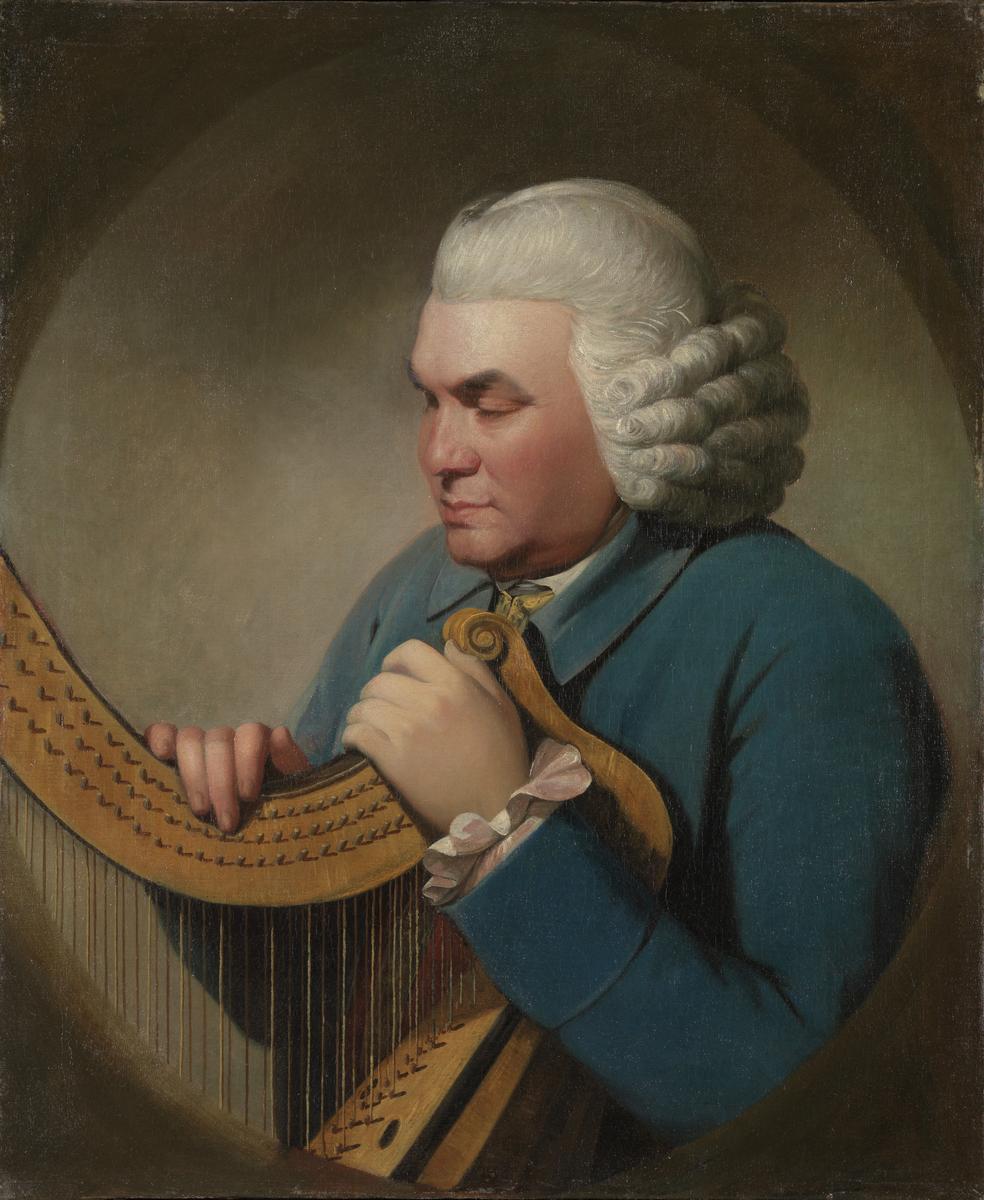
William Parry, Portrait of John Parry Holding his Harp 1780–90
This portrait shows the celebrated Wesh musician John Parry, sensitively painted by his son William Parry. John Parry’s reputation as ‘the famous blind Harper’ is visualised here – he is shown with his eyes closed (as was conventional for blind sitters) and holding a Welsh triple harp. Rather than playing this instrument, John’s hands rest on top and he appears lost in thought. This may allude to his perception of the world through his other senses, like touch and sound. John’s deep contemplation also evokes the poetic, other-worldly nature of music, associating him with the popular, romantic image of the Welsh bard. This might be the portrait William Parry exhibited in 1787 as a posthumous tribute to his father.
Gallery label, October 2023
11/30
artworks in The Exhibition Age
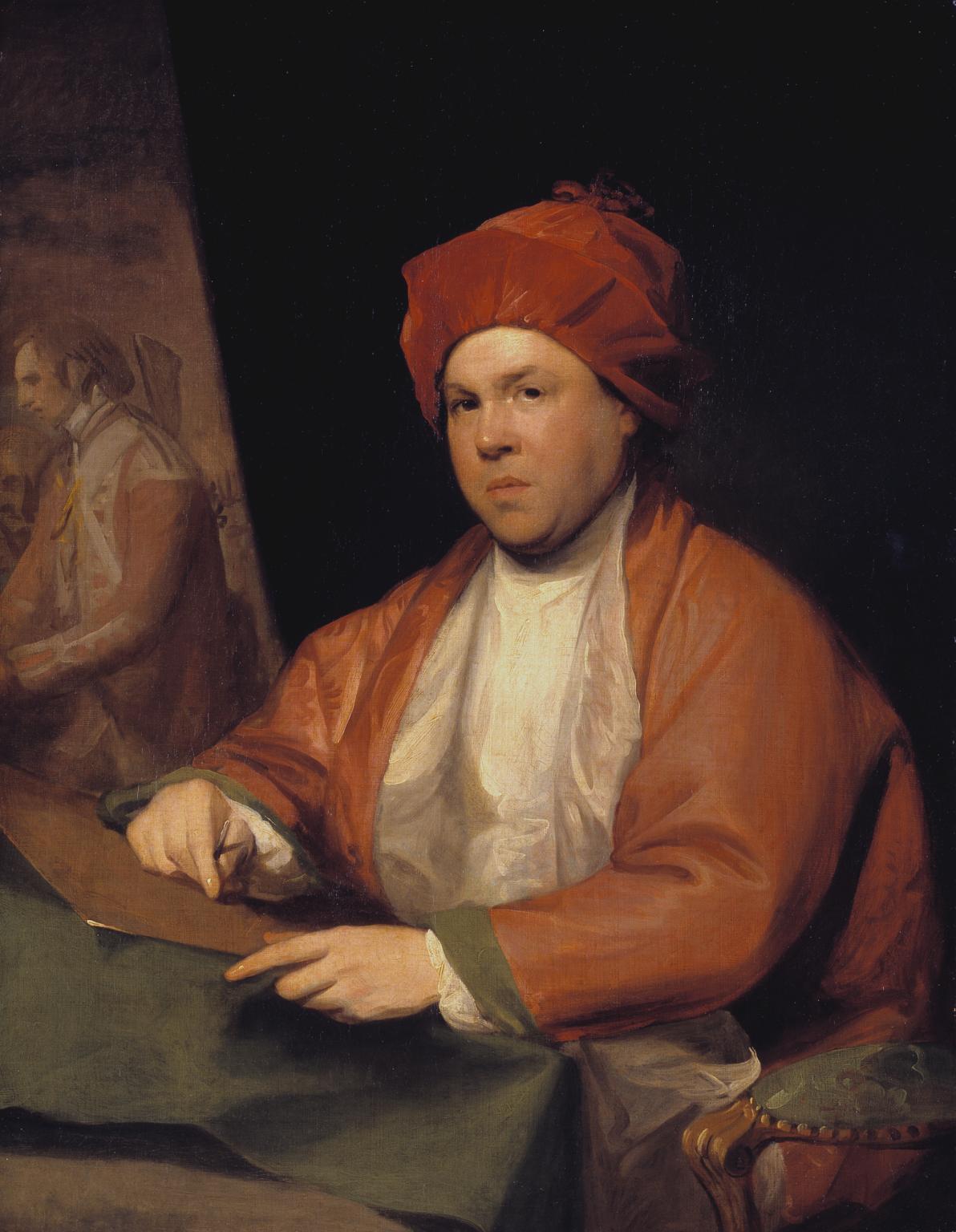
Gilbert Stuart, William Woollett the Engraver exhibited 1783
This striking portrait depicts the engraver, William Woollett. With a copper plate in front of him and a burin or graver in hand, he looks up as if momentarily distracted from his work. The painting in the background offers the clue to his activity – it is recognisable as the acclaimed Death of General Wolfe by Benjamin West, which Woollett engraved in 1776. This was Woollett’s most commercially successful print. Gilbert Stuart’s portrait not only celebrates the engravers’ achievements, but also an important artistic collaboration. When Stuart exhibited the painting in 1783, it was praised for showing ‘the man himself’.
Gallery label, February 2024
12/30
artworks in The Exhibition Age
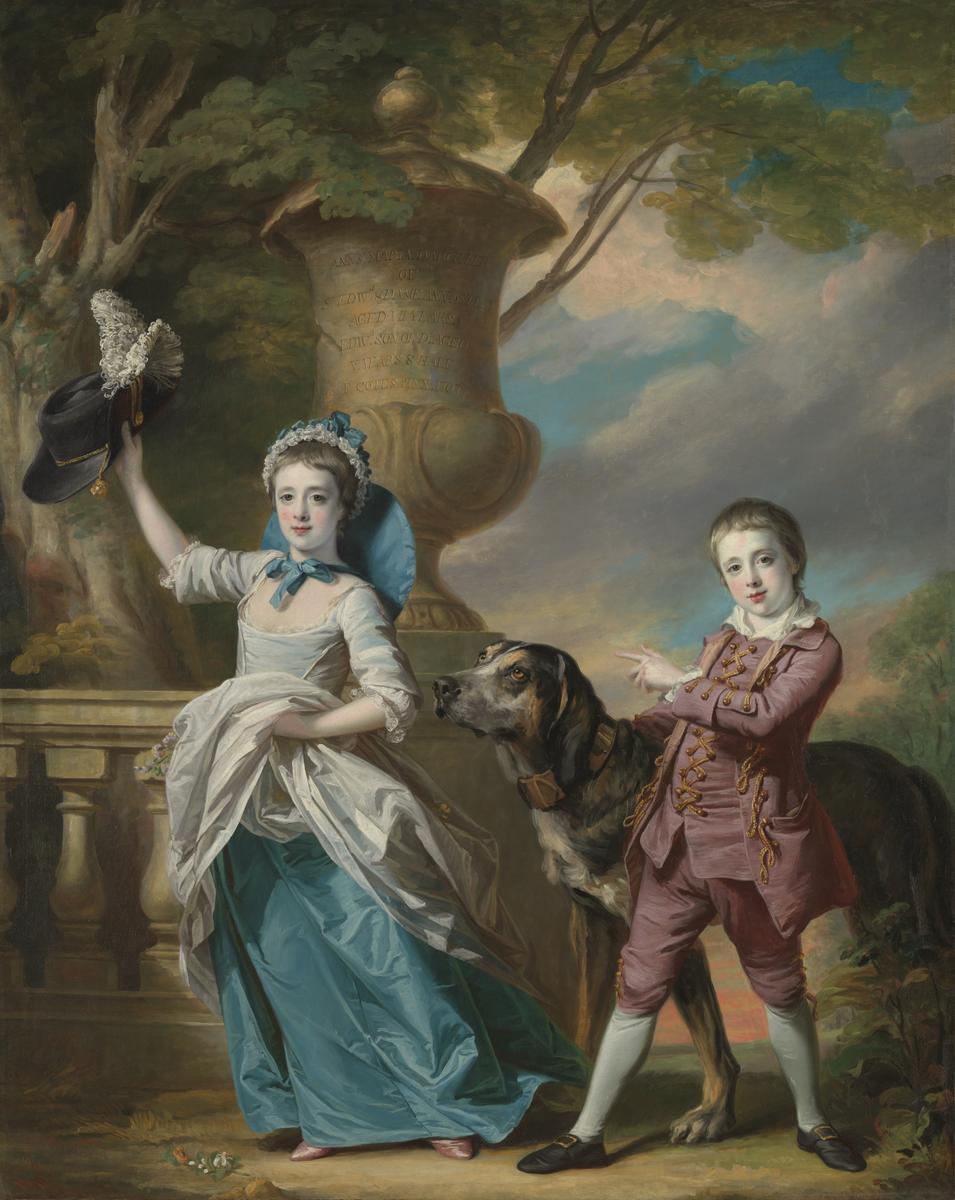
Francis Cotes, Anna Maria Astley, Aged Seven, and her Brother Edward, Aged Five and a Half 1767
The children in this portrait were the offspring of wealthy baronet and landowner Sir Edward Astley and his second wife Anne Milles. They are depicted at play on a classical terrace, reminiscent of the family’s grand estate at Melton Constable, Norfolk. Anna Maria, who waves her brother’s plumed hat above her head, died in childhood, the year after this portrait was painted. Edward, whose elder half-brother was to inherit his father’s title, lived to carve out a successful career as a soldier in the British army. It is thought that the portrait was commissioned by the children’s maternal grandfather.
Gallery label, February 2010
13/30
artworks in The Exhibition Age
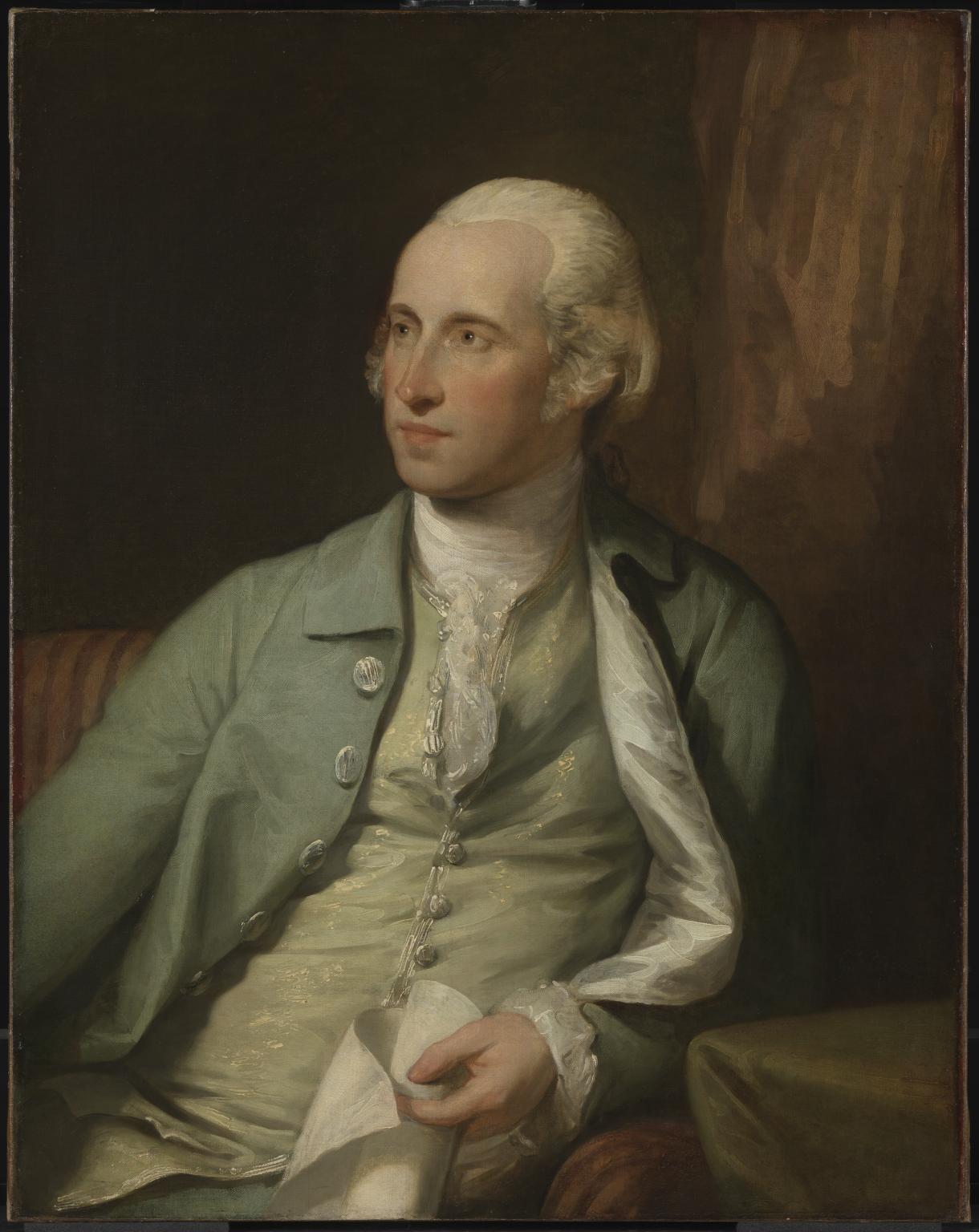
Gilbert Stuart, Benjamin West, P.R.A. ?exhibited 1781
The American-born painter Benjamin West was one of the most successful artists of his generation. He was one of King George III’s favourite artists, which gave him privileges and wealth that made him the envy of his contemporaries. This polished portrait suggests an affluent and genteel personality.
West’s studio in London was a gathering place for Americans studying art in Europe. Many of these returned home to pursue careers in their newly independent homeland. This portrait is by one of West’s most successful American students, Gilbert Stuart.
Gallery label, August 2004
14/30
artworks in The Exhibition Age
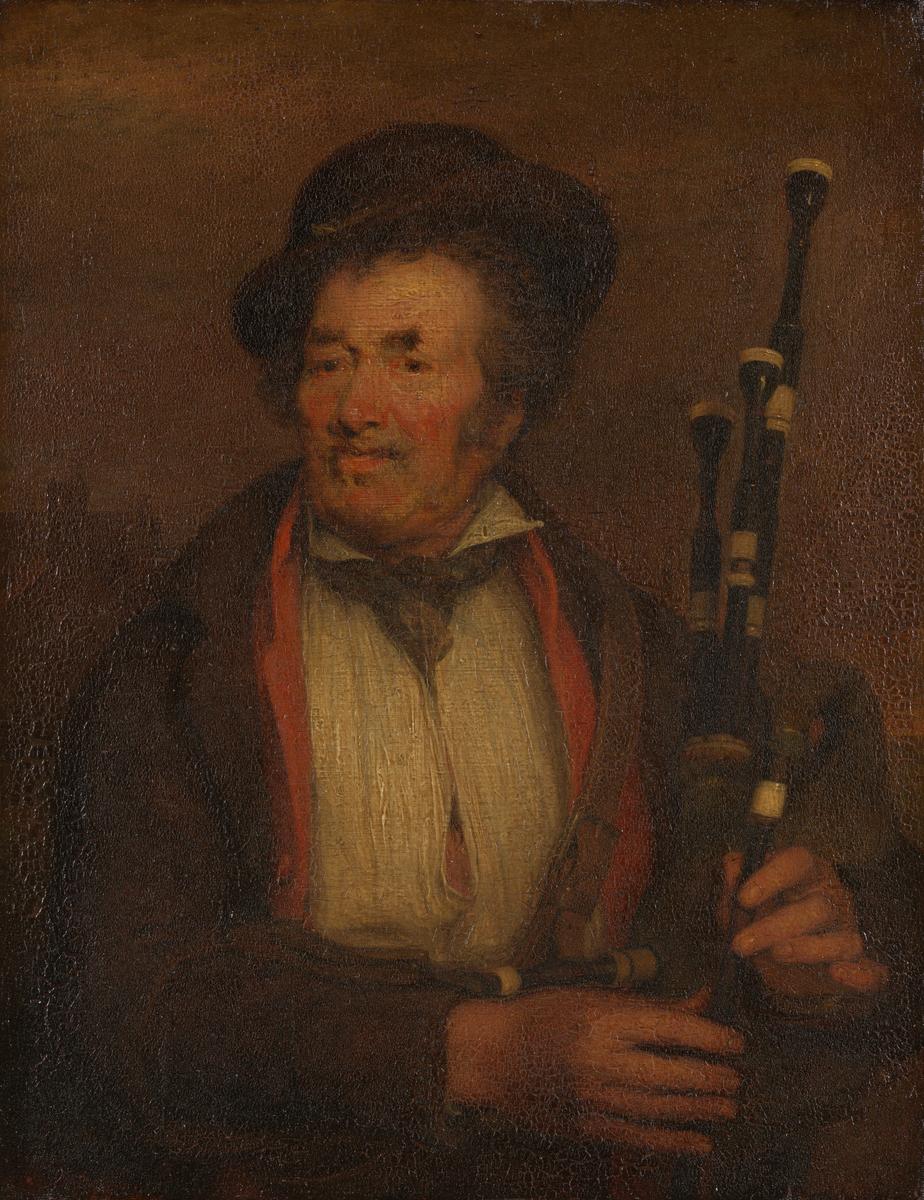
Sir David Wilkie, The Bag-Piper 1813, exhibited 1813
David Wilkie had already made his name in the London art world when he painted this small picture. It shows a bagpiper seemingly lost in thought, his fingers poised to play. One early biographer claimed this subject had been in Wilkie’s mind since boyhood and includes the old kirk (church) of his hometown, Cults, in the distance. While this is debatable, the explicitly Scottish subject is unusual in Wilkie’s work at this time. He exhibited this painting at the British Institution in 1813. While this may reflect his hope to raise the status of Scottish art, The Bag-Piper also appealed to a romanticised image of Scotland.
Gallery label, February 2024
15/30
artworks in The Exhibition Age

Joseph Mallord William Turner, The Garreteer’s Petition exhibited 1809
The scene shows a young poet struggling for inspiration late at night in his garret, a cramped attic room. On the wall is an image of Mount Parnassus, the mythological home of the Greek Muses, indicating his high ambitions. Though the point of the image seems to be satirical, the picture was exhibited at a time when Turner was writing poetry himself so likely sympathised with the poet’s predicament. Turner rarely painted explicitly figurative works but may have been inspired to do so due to his rivalry with David Wilkie whose genre subjects were extremely popular in London’s exhibitions.
Gallery label, February 2024
16/30
artworks in The Exhibition Age

John Opie, Portrait of a Lady in the Character of Cressida exhibited 1800
We do not know the identity of this woman, but she is probably a celebrity or actress who contemporary viewers would have recognised. Opie was working at a time when fame was becoming an increasingly important part of artistic success. This painting appeared at the Royal Academy’s annual exhibition in 1800. Artists jostled to grab public attention, painting more flamboyant and dramatic pictures. Opie depicts his sitter as the heroine of Shakespeare’s tragedy Troilus and Cressida.
Gallery label, October 2019
17/30
artworks in The Exhibition Age
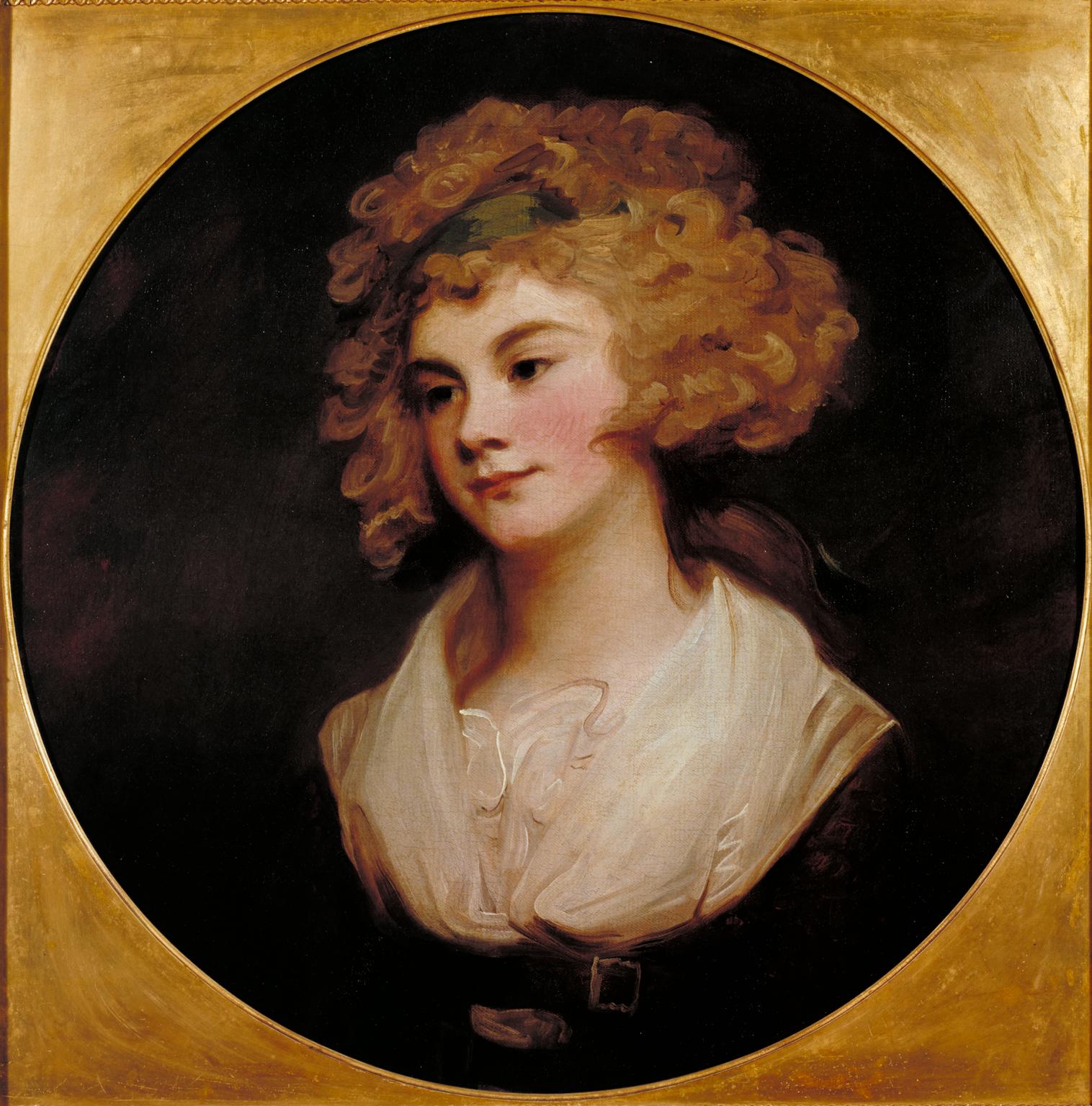
George Romney, A Lady in a Brown Dress: ‘The Parson’s Daughter’ c.1785
George Romney was one of London’s most fashionable portraitists. He was particularly admired for the charm and simplicity of his female portraits. He chose not to exhibit his works publicly after 1772, instead relying on word of mouth for private commissions. Romney became known for his virtuoso ‘performances’ at sittings, quickly painting the sitters’ likeness directly onto the canvas. This painting demonstrates the artist’s loose, expressive brushwork. We do not know the identity of the sitter, but later, in the second half of the 19th century the work became widely known as ‘The Parson’s Daughter’.
Gallery label, February 2024
18/30
artworks in The Exhibition Age
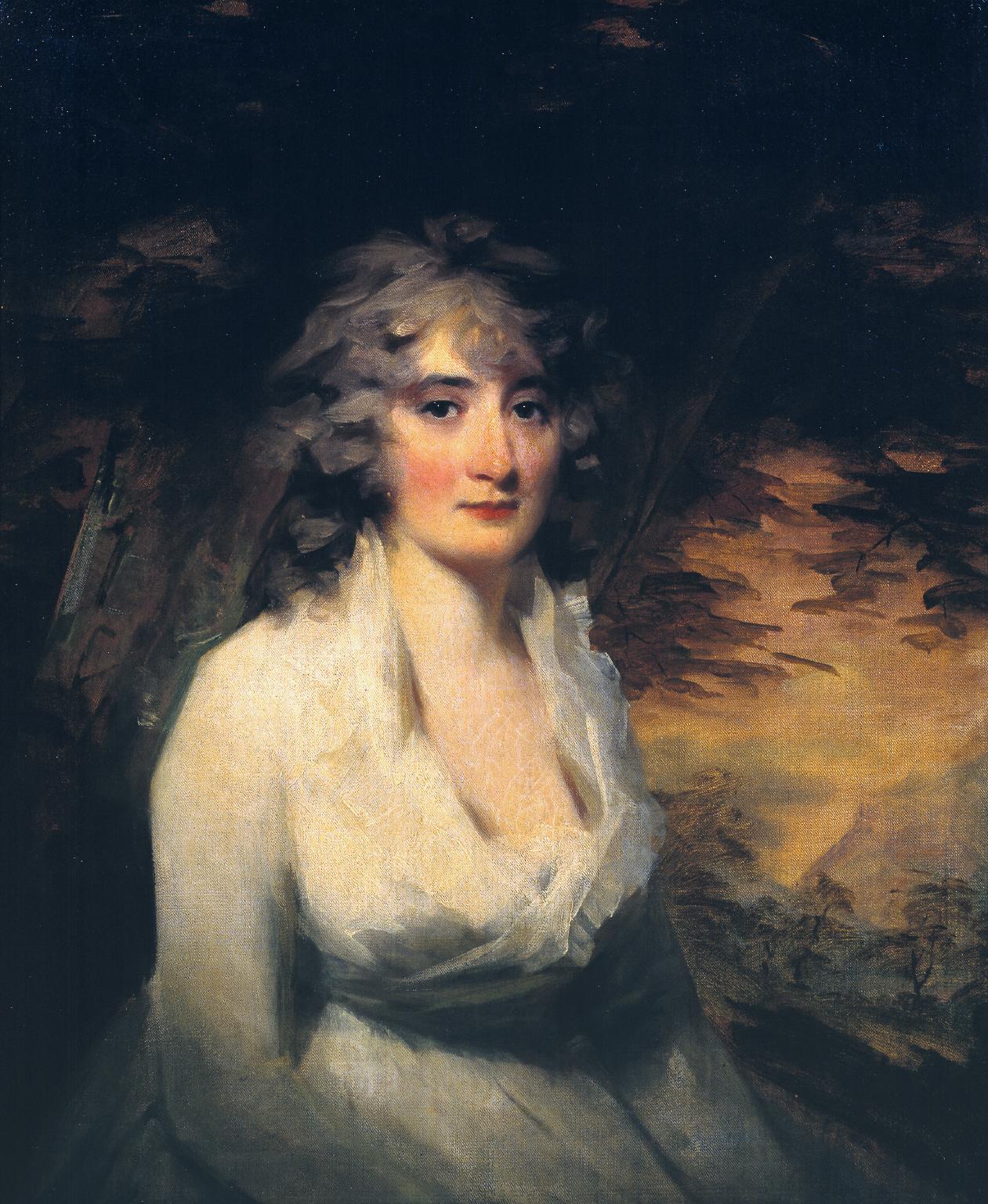
Sir Henry Raeburn, Mrs H.W. Lauzun ?1796
This painting depicts Anne Neale Lauzun (1776–1861), née Tucker. Born in Bermuda, her family were part of the British colonial administration. She spent her youth in Bermuda before moving to Edinburgh in 1792. Henry Raeburn painted this portrait in Edinburgh, possibly to commemorate Tucker’s marriage to Lieutenant Henry William Lauzun in 1796. The strong central light source and loose brushwork in this painting, reflect Raeburn’s cultivation of his own unique style as his career progressed.
Gallery label, October 2023
19/30
artworks in The Exhibition Age
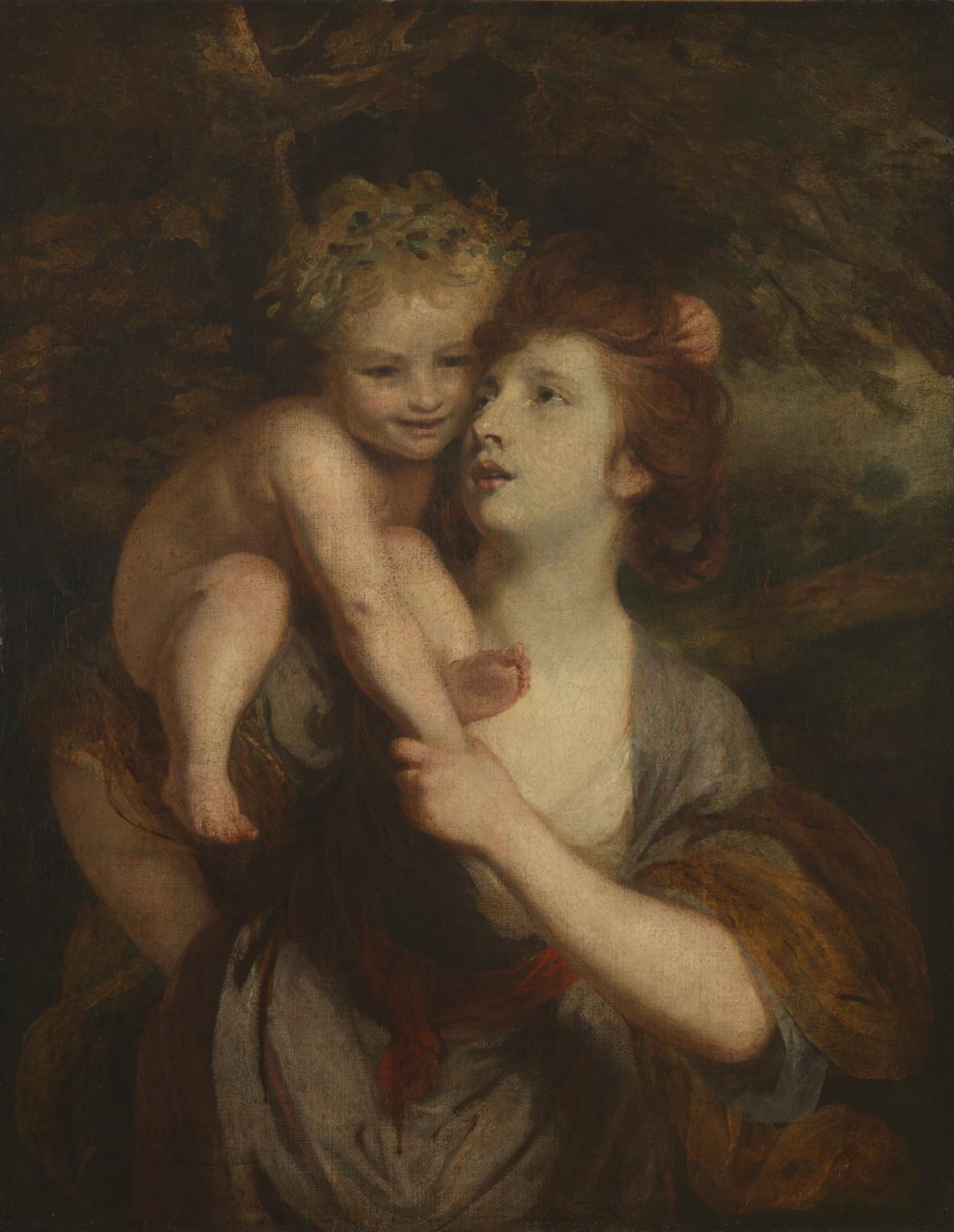
Sir Joshua Reynolds, Mrs Hartley as a Nymph with a Young Bacchus exhibited 1773
Elizabeth Hartley (1751-1824) is depicted here as a mythological figure. She holds a young Bacchus, the ancient Greco-Roman god of wine and festivity. By the time this painting was exhibited at the Royal Academy in 1773, Hartley was one of the most celebrated actresses on the London stage. Reynolds exhibited this painting with the title ‘A Nymph with Young Bacchus’. It was not presented as a portrait of Mrs Hartley, but as a subject or ‘fancy’ picture. Such pictures incorporated imagined elements into a scene, particularly of women and children.
Gallery label, October 2023
20/30
artworks in The Exhibition Age
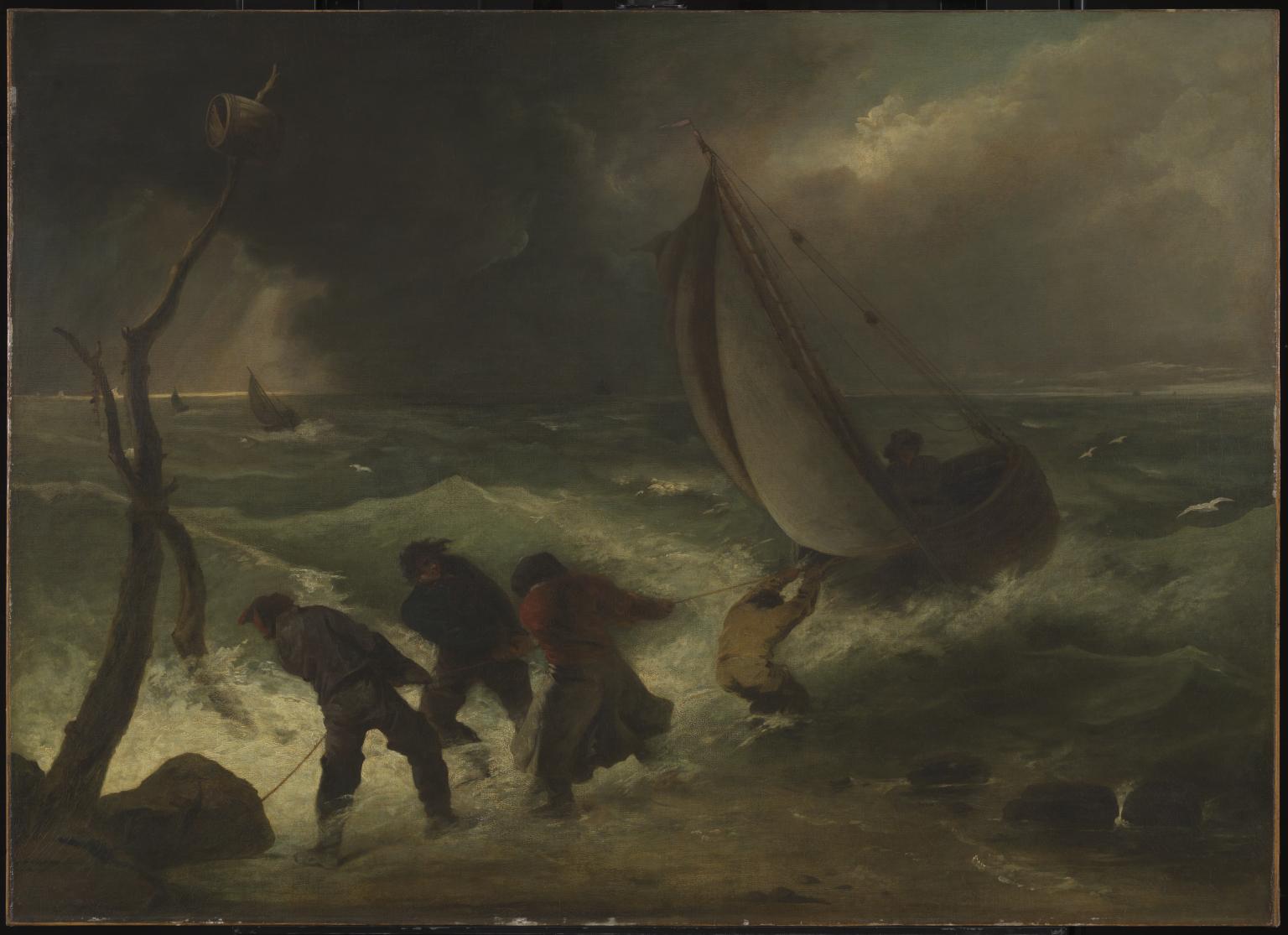
John Hoppner, A Gale of Wind c.1794
John Hoppner was one of the leading portraitists of his day. When he exhibited this painting at the Royal Academy in 1794, it would have stood out to exhibition-goers as a highly unusual subject for the artist. Indeed, this is the only work Hoppner is known to have exhibited that wasn’t a portrait. We think the stormy seascape is set just off St Catherine’s Point in the Isle of Wight, an area known for its dangerous waters. The painting gave Hoppner an opportunity to show off his expressive brushwork and his ability to convey drama and narrative. Capturing a sense of the artistic competition of the time, one critic remarked: ‘The present aggression is incontestably bold, and well executed, and should be rewarded with a booty of reputation.’
Gallery label, February 2024
21/30
artworks in The Exhibition Age

John Hoppner, Miss Harriet Cholmondeley exhibited 1804
22/30
artworks in The Exhibition Age
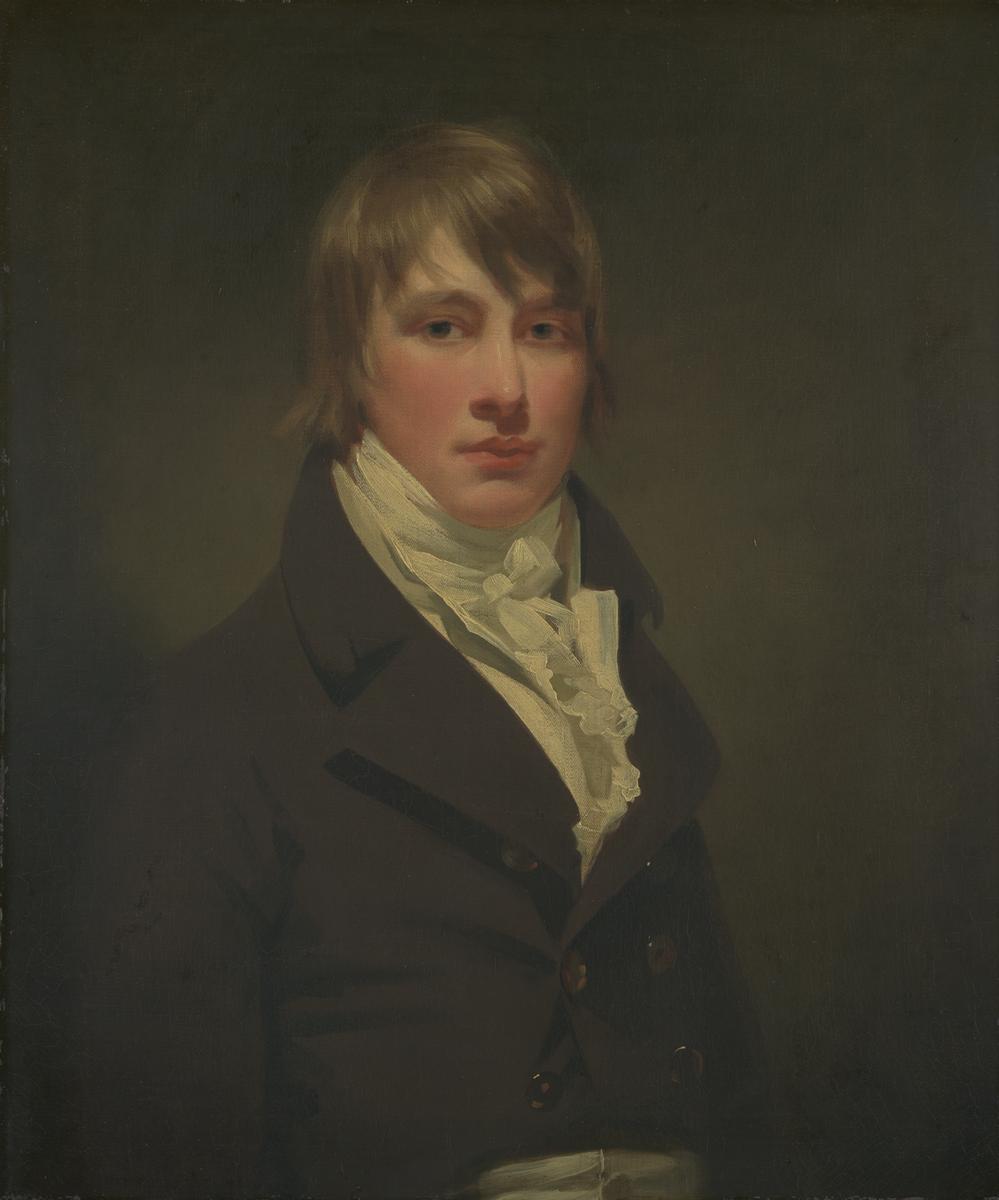
Sir Henry Raeburn, Pringle Fraser c.1804
Pringle Fraser was born in Lanarkshire, Scotland, in 1787. Here, he is around 17 years old. The dramatic lighting focusses attention on his face, illuminated against the dark, restrained background. This striking light effect and the fluid handling of paint suggests Henry Raeburn’s growing artistic confidence. By this time, Raeburn was celebrated as one of Scotland’s greatest portraitists. As an adult, Fraser travelled to India and joined the East India Company’s army, eventually becoming a Captain in the 7th Regiment in the Madras Native Infantry.
Gallery label, October 2023
23/30
artworks in The Exhibition Age
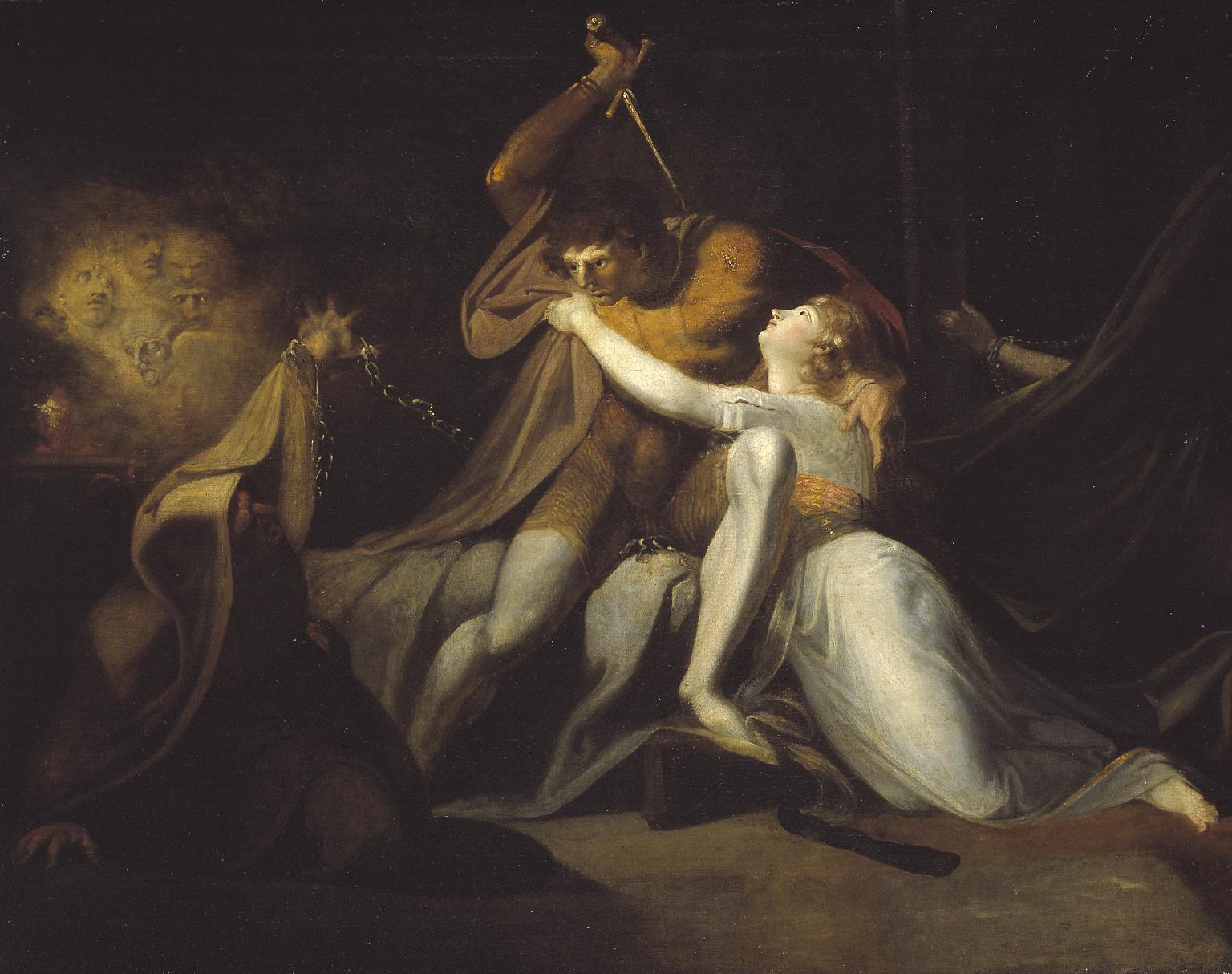
Henry Fuseli, Percival Delivering Belisane from the Enchantment of Urma exhibited 1783
Waking from an enchanted sleep, Percival is shown raising his sword to strike the wizard Urma. Meanwhile, his lover, Belisane, clings to his side. Although Henry Fuseli claimed this story was from the ‘Provencal Tales of Kyot’, it was actually his own invention. At first glance, this painting seems to depict the kind of heroic scene associated with grand manner painting. However, it disregards the noble themes and moral lessons such painting usually demanded. Instead, Fuseli’s strange and supernatural imagery emphasises emotional drama and spectacle. This played into Fuseli’s persona as a wild eccentric, equally admired and reviled by contemporaries.
Gallery label, February 2024
24/30
artworks in The Exhibition Age
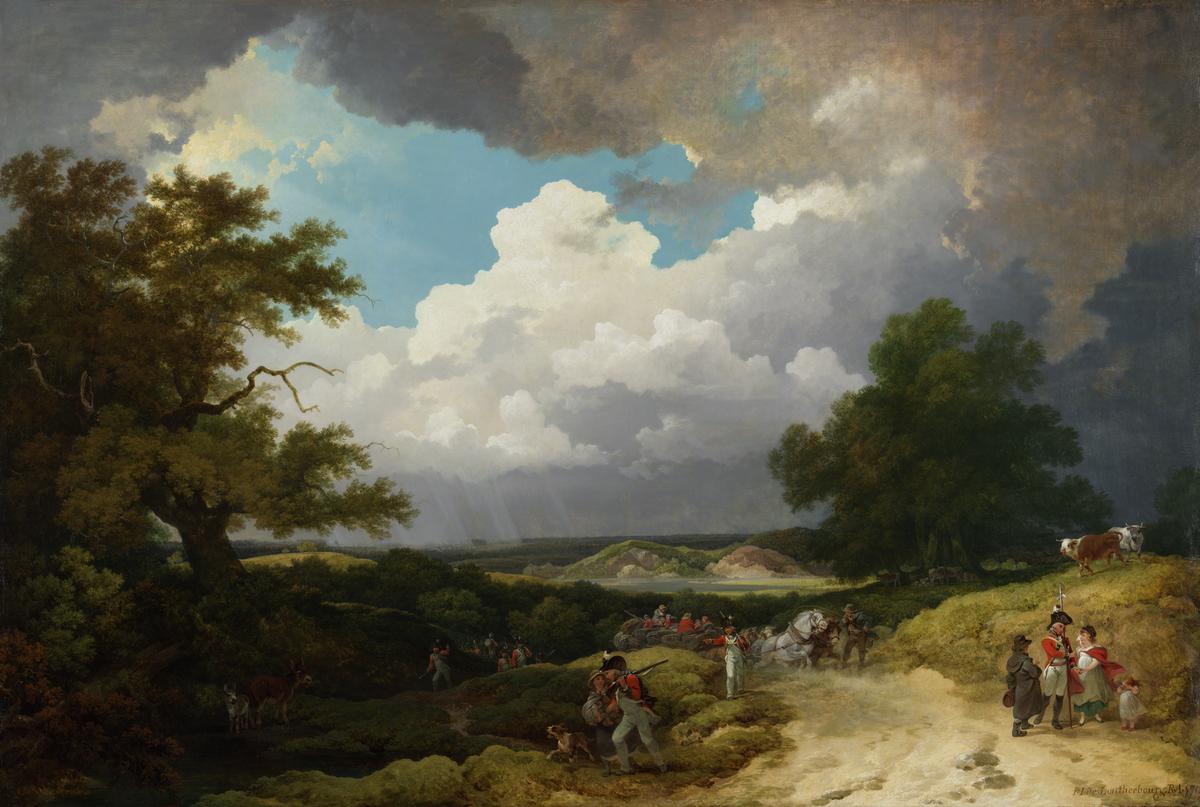
Philip James De Loutherbourg, A Distant Hail-Storm Coming On, and the March of Soldiers with their Baggage 1799
As the war against France continued during the 1790s, Philip James de Loutherbourg increasingly turned his attention to military and naval subjects. Rather than depicting a grand battle, here he emphasises the domestic impact of war. British soldiers march through the countryside, leaving tearful families behind. The dark clouds and stormy weather only increase the sombre, foreboding mood. When this painting was exhibited in 1799, one reviewer commented on its appeal to the viewer’s emotions, praising the ‘variety of beauties which cannot be easily described, but are felt by the connoisseur on the first view.’
Gallery label, February 2024
25/30
artworks in The Exhibition Age
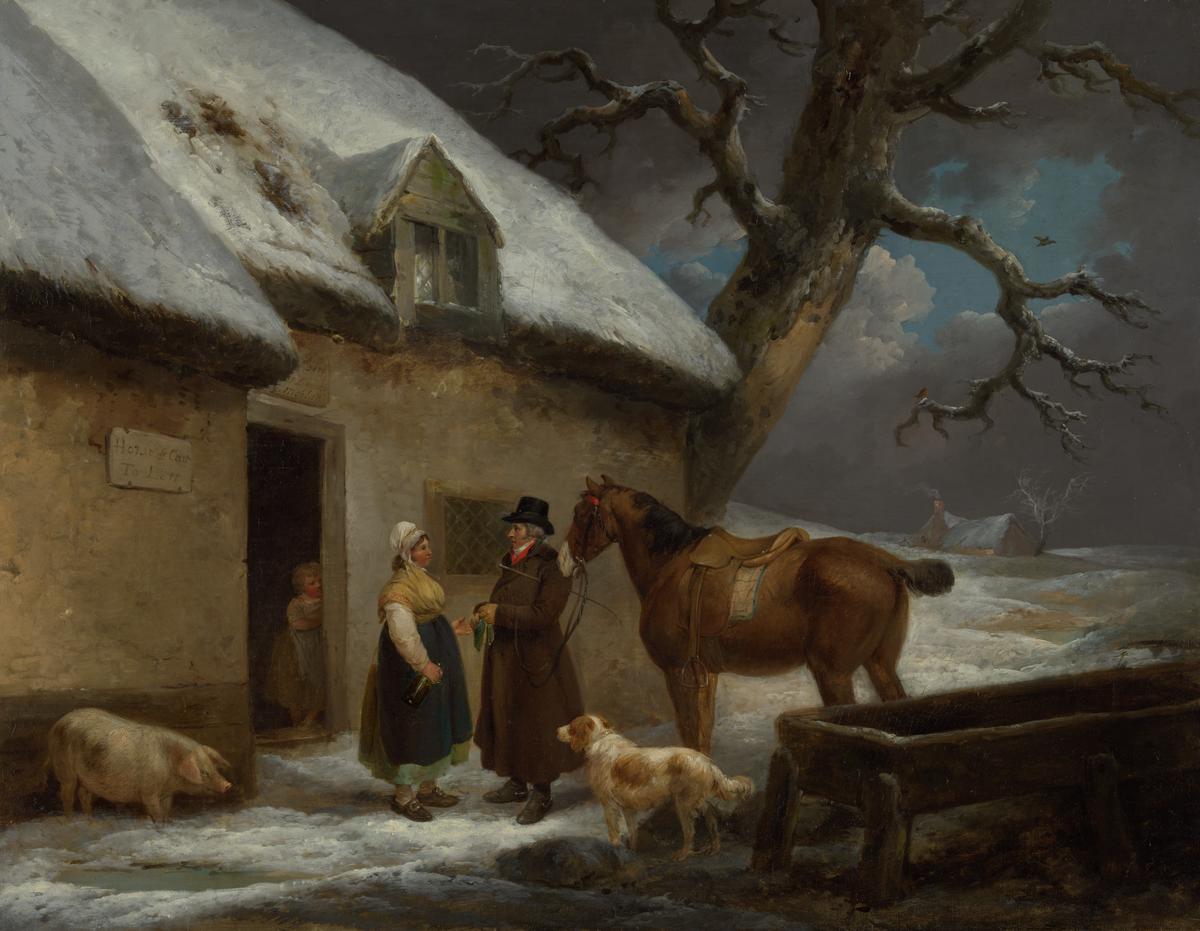
George Morland, Outside an Inn, Winter c.1795
George Morland was known for painting rustic country life. Here, he depicts a man departing from an inn, watched by a child from the open doorway. The traveller’s thick coat and shiny top hat suggests his affluence, in contrast with the humble inn keeper, who keeps a pig for food. The scene’s stark surroundings underscore the hardship of rural life. However, Morland may have been appealing to the popular market for simple, picturesque country scenes. At this time Morland began working on a smaller scale and often recycled compositions in order to increase his output. This painting is similar to an earlier print, and doorway exchanges regularly feature in Morland’s work.
Gallery label, February 2024
26/30
artworks in The Exhibition Age
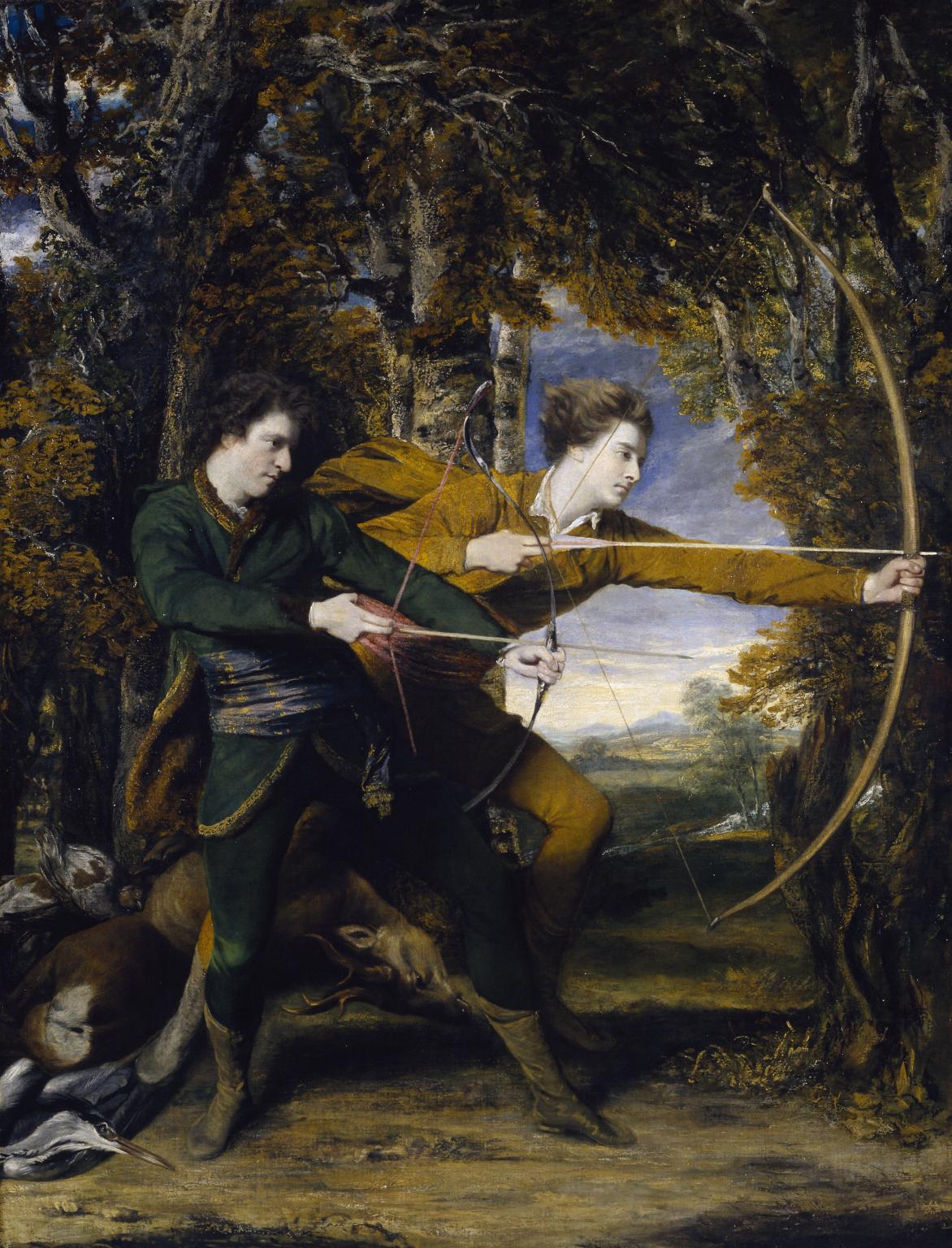
Sir Joshua Reynolds, Colonel Acland and Lord Sydney: The Archers 1769
This portrait depicts two young aristocrats. Dressed in quasi-historical clothing invented by the artist, they are mimicking a medieval or Renaissance hunt; the dead game they leave in their trail underlining their noble blood and aristocratic right to hunt. This painting celebrates their friendship by linking it to an imaginary chivalric past, when young lords pursued ‘manly’ activities together against a backdrop of ancient forest. The subjects are shown in perfect harmony – at one with each other and joint masters over nature.
Gallery label, February 2016
27/30
artworks in The Exhibition Age
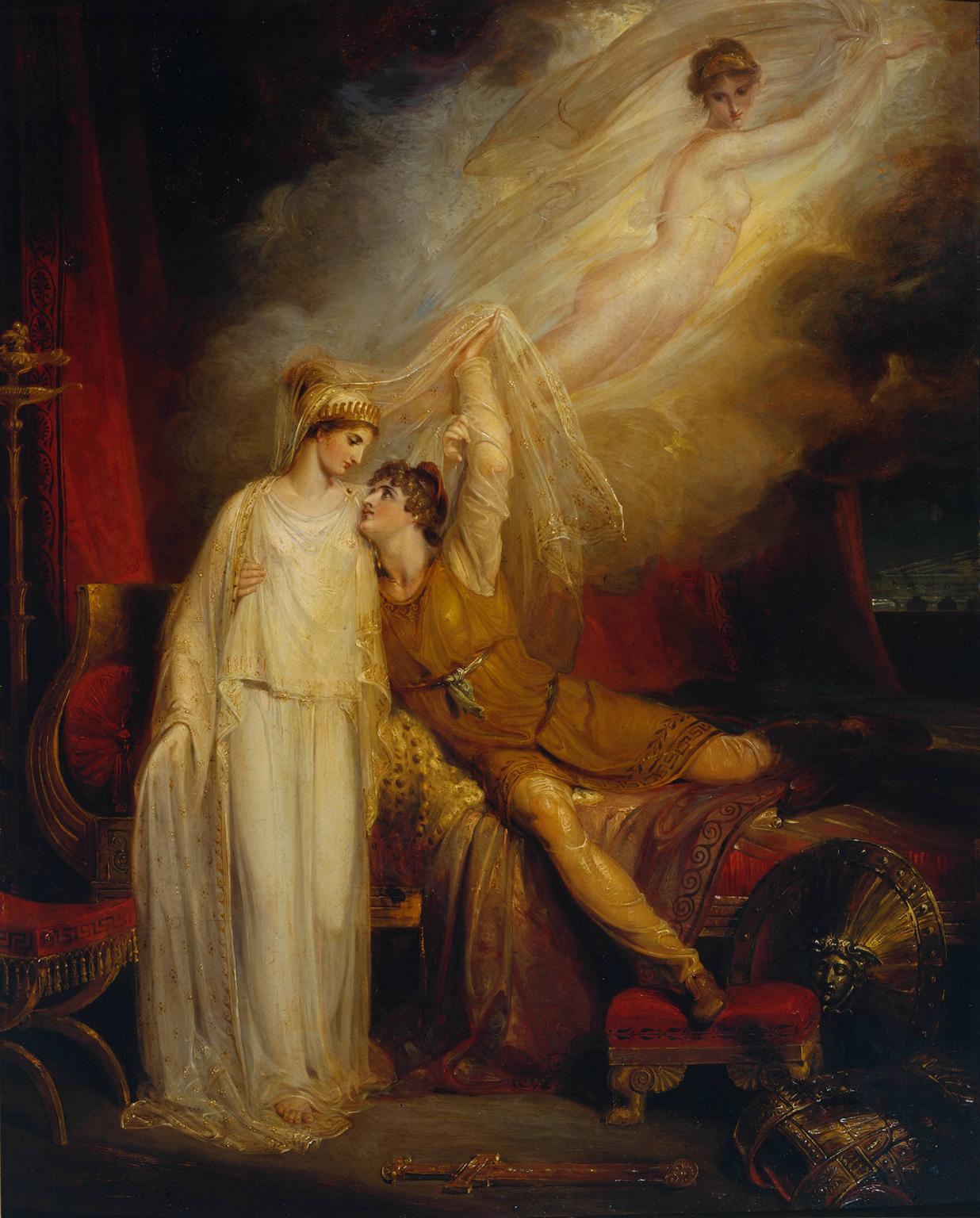
Richard Westall, The Reconciliation of Helen and Paris after his Defeat by Menelaus exhibited 1805
This painting is inspired by Greek legend: Helen was married to Menelaus, king of Sparta. Her affair with the Trojan prince, Paris, led to the Trojan War. Richard Westall painted this scene for Thomas Hope, a wealthy collector. His London home had rooms designed and furnished in the different styles of the ancient world – Egypt, India, Greece and Rome. Westall modelled the figure of Helen on a Greek statue in Hope’s collection. In the 1790s Westall’s Royal Academy exhibits were the talk of the town. His flashy paint effects divided opinion, however, and many thought his work was too stylised and unnatural.
Gallery label, February 2024
28/30
artworks in The Exhibition Age
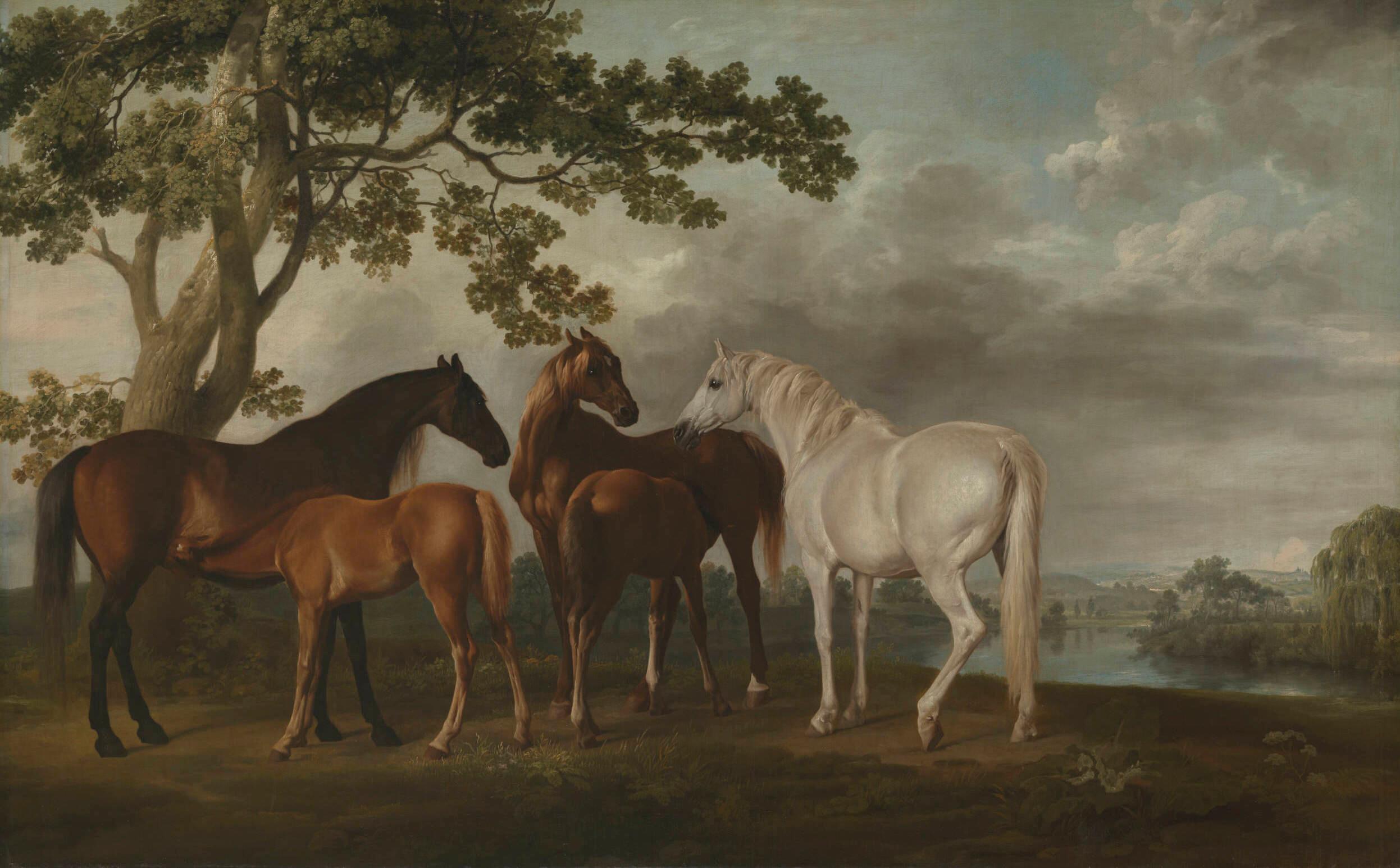
George Stubbs, Mares and Foals in a River Landscape c.1763–8
This painting seems to have been used as an ‘overdoor’, hung with two other pictures by Stubbs above the doors in the dining room of George Brodrick, 3rd Viscount Midleton, MP (1730–65). Reflecting the ornamental use to which this painting was to be put, it seems that Stubbs, the premier animal painter of his day, did not set out to be especially original. The figures of the horses are the same as those appearing in another painting, a commission for Lord Rockingham representing specific horses owned by him, although the colour of one has been changed from brown to grey.
Gallery label, February 2016
29/30
artworks in The Exhibition Age
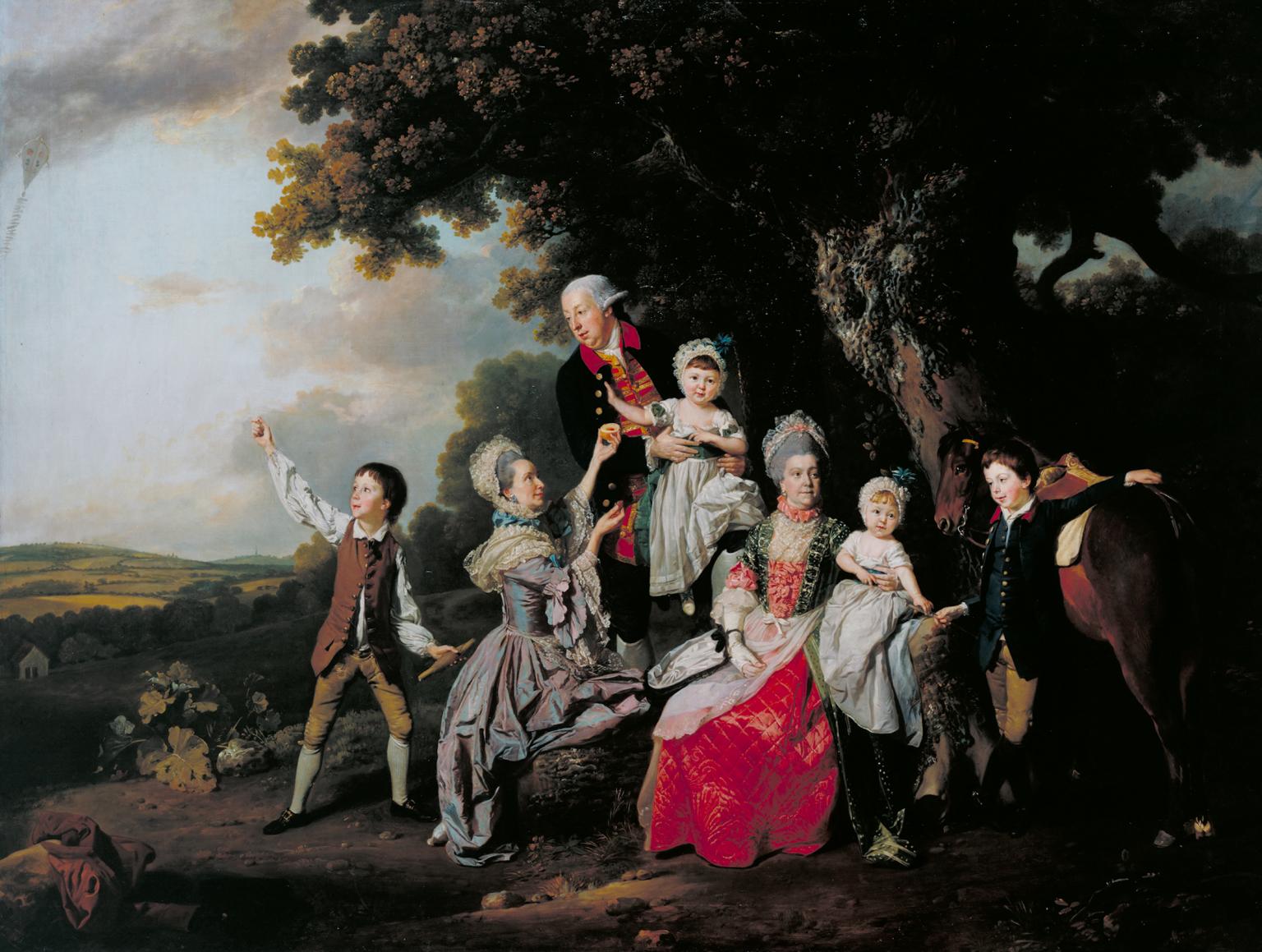
Johan Zoffany, The Bradshaw Family exhibited 1769
Small-scale group portraits like this, known as ‘conversation pieces’, projected an idealised vision of family life. This picture employs a pyramidal arrangement of the figures to express the structure of the family. Thomas Bradshaw (1733–74), a senior civil servant and politician, is shown at the apex of the pyramid. His family is arranged below him. The two women are Bradshaw’s wife, Elizabeth on the right, and, on the left, probably his sister. The two oldest sons are shown at the far left and right of the group. Their position in the composition serves to associate them both with the sheltered space of the family unit, and the outside world.
Gallery label, February 2016
30/30
artworks in The Exhibition Age
Art in this room

Sorry, no image available




























You've viewed 6/30 artworks
You've viewed 30/30 artworks
